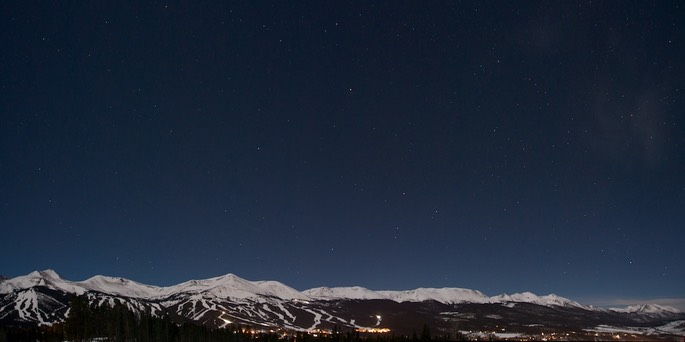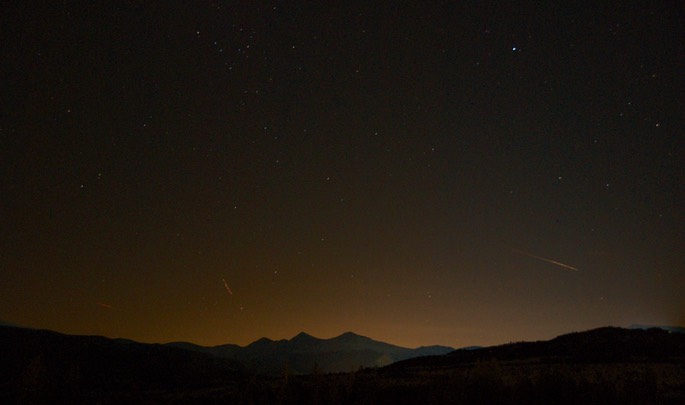Moonlit panorama taken of Ten Mile Range, Summit County, CO. ISO 800, 15 seconds, 35 mm, f/4.2
With the recent interest in night-time photography I decided to delve into it a bit. I took a lot of shots in the Colorado mountains this winter, where the air is pretty clear and there is not too much light pollution. I found out some things that are might be helpful to others and will share them in this post.
These websites, pointed out to me by Rick Capozza, were helpful in getting started:
Ben Canales tutorial: http://vimeo.com/16833554
http://www.cambridgeincolour.com/tutorials/night-photography.htm
http://www.treehugger.com/natural-sciences/10-extraordinary-photographs-of-the-starry-night-sky.html
Based on this info and the experience gained over several nights' work, here's what I found:
Equipment:
1. Use a low noise camera. This will be very important especially if there is no moon. Any of the newest DSLRs should be OK. The Nikon D200 is not OK.
2. A super-high ISO camera is helpful but not required. A more sensitive camera will allow you to reduce the shutter speed and avoid star tracks.
3. Use a wide angle lens or a zoom, something around 18mm. I used a 18-200mm Nikon f/3.5-5.6. A faster lens would be better to allow lower ISO when using something like a D200.
4. A tripod is required, and a camera level is helpful. A headlamp is better than a flashlight.
5. If it's cold be sure to have gloves, hat, and warm clothing.
Moonlit panorama taken of Ten Mile Range, Summit County, CO. ISO 640, 20 seconds, 18 mm, f/3.5
Sample shots:
Since you cannot see anything through the viewfinder, and very little on the LCD, take a sample shot to get the composition you want. Set the camera for manual exposure, ISO as high as it will go, use a 10 sec shutter speed (or longer if it's really dark), manual focus set to infinity (or close to it). Open the aperture all the way (lowest f-stop) and set the zoom to its minimum focal length to start. For the sample shot you don't need a cable release or mirror lock up, but if you have them already set up, all the better. Also, be sure vibration reduction is turned off.
Take as many shots as you like adjusting the zoom, ballhead, tripod, etc. and decide which set-up you want to use for the real shot.
Real Shot:
Now you need to set the ISO to a lower value, based on your experience for the maximum you can use without getting noise. Better yet, try several different settings.
The next thing to determine is the shutter speed minimum. The "Rule of 600" is useful to determine what the maximum shutter speed can be to avoid star tracks. For full frame cameras, divide 600 by the focal length. At 18 mm you get 33 seconds, so set the camera to 30 sec. If you are using a cropped sensor camera, divide again by the crop factor. For a Nikon DX with 1.5 crop factor, you'll get 22 seconds, so use 20.
Use a cable release and mirror lock-up to avoid vibrations.
Problems:
I ran into a few problems, and the main one was noise. My D200 is not a low noise camera. At ISO more than 640 or 800, the noise becomes objectionable. Another problem was the amount of light pollution. What was hardly noticeable with the naked eye became very obvious in some photos. The last problem I ran into was airplanes: some photos were plagued by airliners' lights streaking across the sky. See the shots below.
Depending on your objective, have some moonlight from behind is helpful to light the foreground. Too much, and the stars are not visible.
Noise is obvious on this moonless night shot, as are star tracks caused by a violation of the Rule of 600. Gore Range, Summit County, CO. ISO 800, 30 seconds, 35 mm, f/4.2
This shot shows both light pollution from Denver, some 80 miles away, and lots of airplanes. Gray's and Torrey's peaks in the center, shot from Frisco, CO. ISO 1000, 15 sec, 35 mm, f/4.
Future Plans:
I'll try more shots in low-light pollution areas. There might be some good places in the Hill Country. Palo Duro Canyon in the Texas Panhandle and Big Bend National Park should be good with both offer some interesting foregrounds. Further away, Utah's national parks would be great places, too.
For equipment, I'm looking at a D600 for a lower-noise/higher ISO camera.



